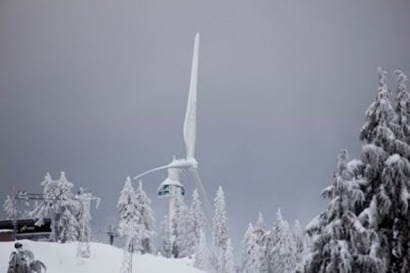
According to published reports, turbines at a $200 million wind farm in northern New Brunswick (Canada) have been frozen solid for several weeks, shutting down the facility providing renewable energy to the province’s primary utility, NB Power.
GDF Suez Energy, the company that owns and operates the site, is working to return the windmills to working order, a spokeswoman says.
"We can't control the weather," Julie Vitek said from company headquarters in Houston. "We're looking to see if we can cope with it more effectively, through the testing of a couple of techniques."
Vitek told reporters that the cold and dry weather that’s typical for the region during the winter would not have posed a problem for the facility; however, this winter’s surprisingly wet weather – and a lack of warmer days to promote thawing, has left the blades coated in thick, unrelenting ice.
The accumulated ice alters the aerodynamics of the blades, rendering them ineffective as airfoils. The added weight further immobilizes the structures.
Vitek said workers are trying to find a way to prevent ice build-up from occurring again in the future.
When working the 99 MW facility has enough capacity to power about 19,000 homes.
So far, the Canadian utility is taking the situation in stride, a spokeswoman explaining that its 20-year purchase agreement with Suez is based on the wind farm’s annual delivery of power, and that fluctuations in production were anticipated.
The same wicked winter weather also reportedly stilled wind turbines in Minnesota, and other US states in the upper Midwest.
According to Venture Beat, a US publication that covers green investment, the deep freeze is already causing concerns in some quarters, where the intermittent nature of wind power already seemed like a risky proposition.
Venture Beat hypothesizes that the problem in the US isn’t ice-covered blades, but rather frozen hydraulic fluid, which proved unfit for the region’s brutally cold winters.
“The temperature continues to drop, these fluids have started to thicken, turning into jelly. This is a big problem, considering how much the Midwest has spent on trying to become the US’s wind power corridor,” the publication said.
In Minnesota the 11 stilled turbines were purchased an installed at a cost of $3.3 million.
If a lasting solution can’t be found, Venture Beat said, that could spark stronger interest in PV solar and solar thermal.
“Minnesota’s frozen wind turbines, each more than 20 years old, may be highlighting brand new concerns about over-reliance on wind as a renewable energy source,” the publication opined. “But even if it was summer and the blades were turning, there’s still a lot of room for improvement in this sector.”
For additional information:

